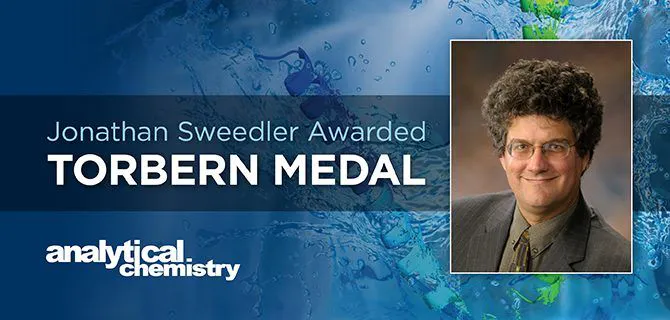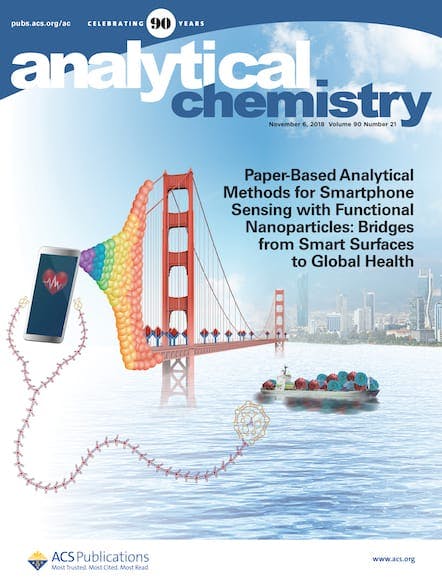Analytical Chemistry Editor-in-Chief Jonathan V. Sweedler received the Torbern Bergman Medal at the inaugural National Meeting of the Swedish Chemical Society, held in Lund, Sweden from June 17-20, 2018. This award is named after famed Swedish chemist Torbern Bergman, who is considered a pioneer in the field of analytical chemistry and known for his 1775 work Dissertation on […]

Sweedler is the James R. Eiszner Family Endowed Chair in Chemistry and Director, School of Chemical Sciences at the University of Illinois at Urbana-Champaign. He has published over 400 peer-reviewed manuscripts, holds 14 patents, and has delivered over 400 invited lectures to universities, companies, and at scientific meetings.
In his most recent research, Sweedler has analyzed the functional peptidomics of stimulus- and time-of-day-specific peptide release in the mammalian circadian clock. Sweedler also recently demonstrated the in situ simultaneous measurements of synaptic cholinergic transmitter concentration and release dynamics and described a simple yet versatile workflow for the cultivation and characterization of model flow-cell-based microbial ecosystems.
Read a Brief Interview with Torbern Bergman Medalist Jonathan Sweedler
What is the “elevator pitch” of your research?
My research is at the intersection of two fields — analytical chemistry and neuroscience. My group and I create new measurement tools that enable small volume chemical analyses, and we apply these tools to understand the chemistry occurring in the brain in a wide range of animals, ranging from comb jellies and sea slugs to mice and monkeys. Using mass spectrometry and capillary separations, we can measure neuropeptides, lipids, and neurotransmitters in individual cells. With these tools, we have discovered biologically active neuropeptides, novel neurotransmitters, and many other interesting compounds. In several cases, we have determined a function of some of the compounds we have discovered.
What drew you to the field of bioanalytical chemistry?
While an undergraduate at UC Davis, two mentors drew me into the field of analytical chemistry. I spent three summers working at the Lawrence Livermore National Laboratory and worked with Tomas Hirschfeld, a brilliant measurement scientist who routinely crossed disciplinary boundaries to solve important problems. In addition, my quantitative analysis professor was Dan Harris (yes, the author of the textbook) and I really enjoyed his teaching style and material. Given these early mentors, it is no surprise I continued in the area of measurement science/instrumental analysis with Bonner Denton and Richard Zare as advisors.
What are the potential real-world applications of your research?
I use our new tools to study cell to cell signaling in the endocrine and nervous systems. Discovering new neurochemical pathways that are conserved across the animal kingdom that are used in critical processes such as memory formation and the control of behavior, can have implications in understanding and treating a range of conditions. As one example, many drugs of abuse co-opt the signaling pathways used by the neuropeptides; understanding how the endogenous systems respond can aid in treatments for addiction. Because of this potential, I have been the PI of a National Institute on Drug Abuse Center for the past decade.
What is the advantage of using mass spectrometry over other analytical techniques?
When studying a complex system such as the brain, one needs to understand what molecules are present, where they are, when they are present and their interaction partners. Mass spectrometry is well suited to answering some of these questions; for example, no other approach can provide greater detail on the chemical inventory of a tissue or brain region. Thus, we use mass spectrometry to assemble the ‘parts lists’ of selected cells in specific brain regions. We can use mass spectrometry imaging to give us unbiased information on their localization. However, getting dynamic information such as is possible with electrochemical measurements or the spatial/temporal information possible from fluorescence imaging are also important. Thus, different approaches are well suited to answer specific questions. Of course, I feel that understanding the molecular players is a critical first step and mass spectrometry excels in this!
Share a turning point or defining moment in your work as a chemist.
While a graduate student looking for postdoctoral positions, I decided to concentrate my measurement science efforts on the brain, and so looked for a position that would allow this. Richard Zare was enthusiastic about such a combined research topic, and so a joint postdoctoral associate position was created with neuroscientist Richard Scheller (both Richards at Stanford). When exploring academic positions, especially in 1990, many universities did not understand the desire or need for interactions across disciplines. However, the UIUC neuroscience program gave me a joint appointment, they helped with my startup, and working with the new interdisciplinary Beckman Institute, I was provided laboratory space among the neuroscientists. My interactions with this group have continued to grow. While these types of interactions and joint positions are much more common now, this was very unusual in 1991. The acceptance by the local neuroscience community changed the direction of my career, enabled me to have impact in measurement science and neuroscience, and defined my research career.
Explore Recent Research Articles By Jonathan Sweedler
Functional Peptidomics: Stimulus- and Time-of-Day-Specific Peptide Release in the Mammalian Circadian Clock
ACS Chem. Neurosci., Article ASAP
DOI: 10.1021/acschemneuro.8b00089
****
Single Synaptic Observation of Cholinergic Neurotransmission on Living Neurons: Concentration and Dynamics
J. Am. Chem. Soc., 2018, 140 (25), pp 7764–7768
DOI: 10.1021/jacs.8b01989
***
A Versatile Strategy for Characterization and Imaging of Drip Flow Microbial Biofilms
Anal. Chem., 2018, 90 (11), pp 6725–6734
DOI: 10.1021/acs.analchem.8b00560
***
A Resource for Our Reagents: ACS Reagent Chemicals
Anal. Chem., 2018, 90 (9), pp 5511–5511
DOI: 10.1021/acs.analchem.8b01729
***
Quantitative SIMS Imaging of Agar-Based Microbial Communities
Anal. Chem., 2018, 90 (9), pp 5654–5663
DOI: 10.1021/acs.analchem.7b05180
***
Newly Identified Aplysia SPTR-Gene Family-Derived Peptides: Localization and Function
ACS Chem. Neurosci., Article ASAP
DOI: 10.1021/acschemneuro.7b00513
***
Molecular and Physiological Characterization of a Receptor for d-Amino Acid-Containing Neuropeptides
ACS Chem. Biol., 2018, 13 (5), pp 1343–1352
DOI: 10.1021/acschembio.8b00167
